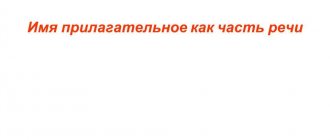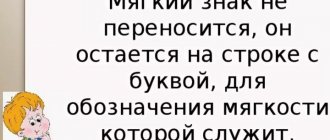Russian language lesson in 2nd grade on the topic “Adjective as a part of speech”
Russian language lesson on the topic
“The concept of an adjective as a part of speech” (2nd grade)
Subject:
The concept of an adjective as a part of speech.
Lesson type:
lesson of learning new material.
Goals:
- Educational
:
introduce students to a new part of speech
- to form mental activity for more effective accumulation and application of knowledge
- develop the ability to put questions to adjectives
:
- determine the role of the adjective in our speech
:
- cultivate interest in the Russian language
Equipment:
poster “Chamomile”, pictures depicting a fox, watermelon, hare;
table “ADJECTIVE NAME”, dummy apple .
DURING THE CLASSES
I. Organizational moment
– Hello, I see who is already ready for the lesson, well done, thank you! Sit down. At the beginning of the lesson I will tell you a parable. One day the padishah decided to put his viziers to the test. “O my subjects! — the padishah addressed them, “I have a difficult task for you, and I would like to know who can solve it.” He led his subjects into the garden, in the corner of which there was a rusty iron door with a huge lock. “Whoever can open this door will become my first vizier,” he said and stepped aside. Some courtiers just shook their heads, others began to look at the lock, others began to hesitantly push the door, but they were convinced that they could not open it .
One by one they walked away from the door.
But one vizier carefully examined the door, felt the lock and pressed the door with all his might. He pushed her and - lo and behold! — she began to give in, first a narrow gap appeared, and then the door began to move faster and opened. Then the padishah said: “You will become the first vizier , because you rely not only on what you see and hear, but you believe in your own strength.”
– I really want you to believe in your own strengths today in class, and then you will succeed. – Today in class we will continue to study the section of the Russian language “Morphology”. (The chamomile poster is hung on the board).
Morphology
– commander over all parts of speech. It was she who collected and combined all the words into parts of speech.
– Look at “Chamomile” and tell me what parts of speech we have already studied in Russian lessons? ( noun, verb)
– You will find out a little later what the part of speech we will get acquainted with today will be called.
2. Preparing to study new material
(2 people work at a board with cards)
– Read the words written on the board:
Runs, grass, shouting, big, green, glass, whistling, flowers, transparent, drying, live, carpet
– Arrange all the words in two columns. The first column contains verbs, the second column contains nouns. – What do the words in the first column mean? – What questions do they answer? – What do the words in the second column mean? – What questions do they answer? – Why didn’t you manage to complete the task: distribute all the words into two columns? – Name the remaining words. – For each noun, select the words that are suitable in meaning from the remaining words and write them down in your notebook along with the question. – What questions do these words answer? – All these words that answer the questions: Which one? Which? Which? Which?
Can be combined into one part of speech: ADJECTIVE (entry closed. Open another petal of the daisy)
- So what will the topic of our lesson be called?
(Open the title of the lesson. Write on the board).
– At the end of the lesson we should be able to answer the questions:
(questions are written on the board)
- What part of speech did you become familiar with?
- What does it mean?
- What questions does it answer?
- What role does the adjective play in our speech?
1) Read the text on the board
An animal was hiding under a bush. He has__________ ears. ___________ tail. The body is covered with ___________ fur. There are _______ and _________ teeth, but he cannot defend himself with them.
Words for reference: timid, long, short, soft, sharp, strong.
(Words are closed for reference)
- Who guessed who we are talking about?
– Agree that this is difficult to do. - Why? (There are no attribute words that refer to this noun).
– From the words for reference, insert words that are appropriate in meaning.
- Now have you guessed? (Hare)
- The listed signs are enough to accurately recognize the object. – What questions do the inserted words answer? – What does it mean? – What is this part of speech called? – There is a table “Adjectives” hanging on the board. Read the rule. Give your own examples. Write the text in a notebook, underline the adjectives with a wavy line.
2) Guess the riddle. (Text written on the board)
Round, round Sweet, sweet, With striped skin smooth. And if you cut it, look, it’s red, it’s red inside.
(There is a picture of a watermelon on the board).
– What signs helped you find out that it was a watermelon? – What feature does the adjective “round” (shape)
, “sweet”
(taste)
, “red”
(color)
.
Notebook entry: Watermelon (what kind?) round, sweet, striped, red.
– Name the adjectives. – What do they mean? – Why is it necessary to know the characteristics of objects and name them?
3). Let's try to describe an apple
- What is it like? (Juicy, yellow, sweet, tasty, ripe, large, beautiful, artificial, aromatic, bulky, appetizing)
Physical education minute
If you hear NOUNS, then stand on your toes and raise your arms up. If you hear ADJECTIVE NAMES, squat down and put your hands on your belt.
GARDENS, CHILD, COLD, SUMMER, CURLY, COUNTRY, POPLAR, YOUNG, STREAM, RINGING, DROP
4) Work from the textbook (orally)
Page 127, exercise 270.
5). Work in pairs
- There are cards on the table. Place them on your desk. Find them among them. nouns Find those signs that relate to a squirrel, a fox. – What are the characteristics that relate to a squirrel? To the fox? – What part of speech are these words expressed? What does it mean?
6) – Let’s try to answer the question: the role of the adjective in our speech. - Close your eyes. Imagine an asphalt gray road. Monotonous and tiresome. And now a summer, forest clearing. Without opening your eyes, tell me what shapes, sizes, colors do you see? – With what part of speech were you able to convey diversity? (Adjectives make our speech picturesque; without them, speech is poor and inexpressive).
7) Creative work (on the board is a picture of a fox).
There are cards on the desks. Insert adjectives that suit their meaning (insert the words into the task card).
Read a few works.
– And here is how the author L.N. Tolstoy describes the fox.
The fox has sharp teeth, a thin snout, a warm fur coat, and the fox is well dressed. The fur is fluffy. There is a vest on the chest and a white tie on the neck.
4. Lesson summary
– We will answer the questions that we read at the beginning of the lesson. – What was useful for you in the lesson? – Where will this knowledge be useful?
Lesson grades.
5. Homework
Learn the rule p.127 Do the exercise. No. 272




